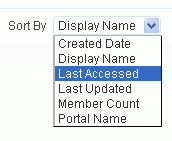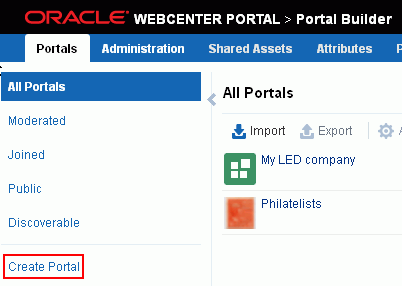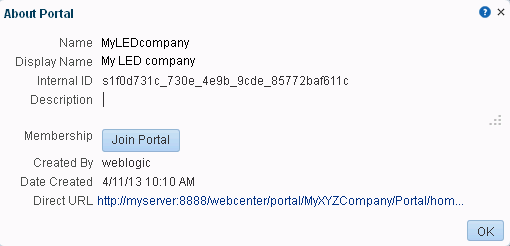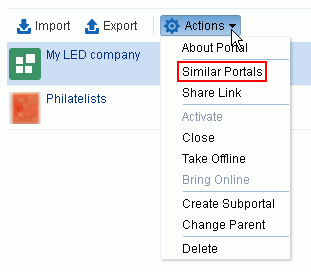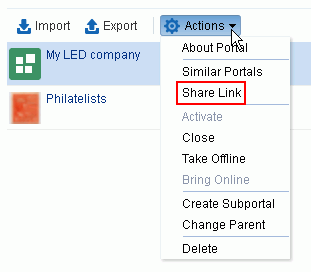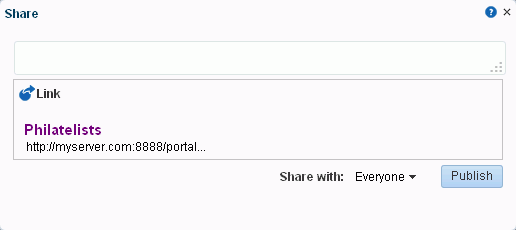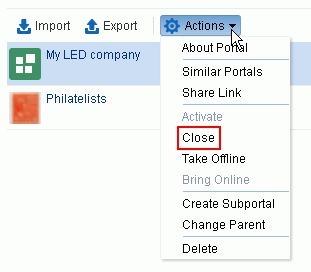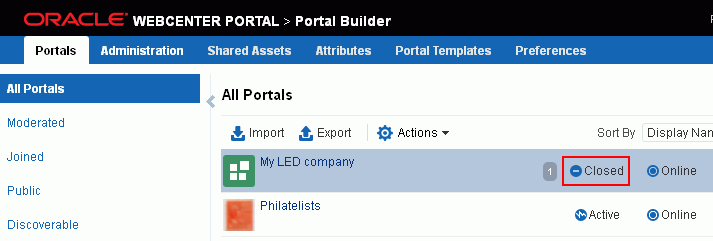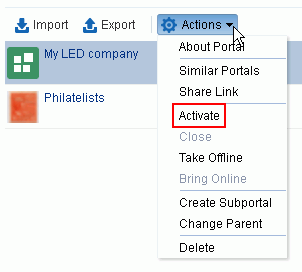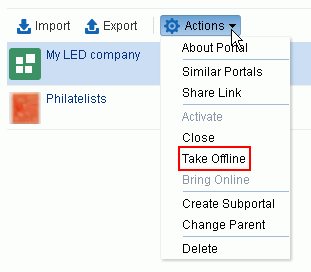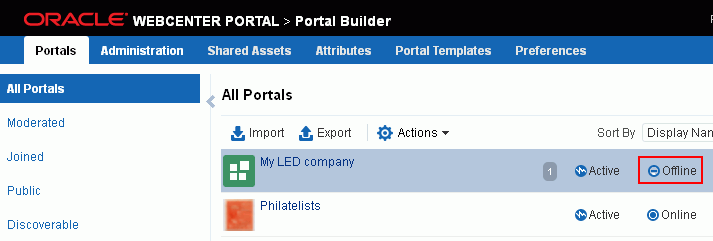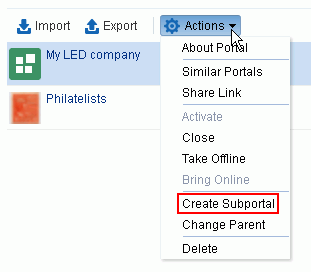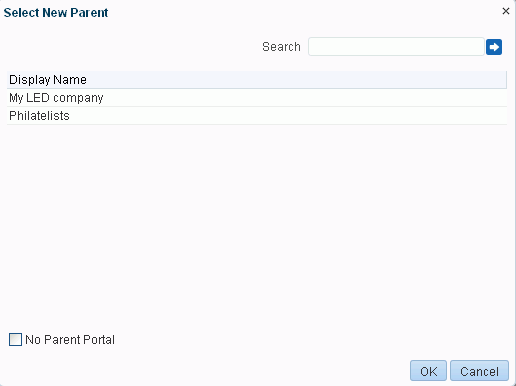46 Exploring the Portals Page in Portal Builder
This chapter describes how to manage portals on the Portals page in Portal Builder.
This chapter includes the following topics:
-
Section 46.2, "Accessing the Portals Page in Portal Builder"
-
Section 46.14, "Moving a Portal or Subportal (Changing the Parent)"
Permissions:
To perform the tasks in this chapter on any portal, you must have the WebCenter PortalAdministrator role or a custom role that grants the following permission:
-
Portal Server-Manage Configuration
If you are a portal moderator (or have Manage Configuration permission in a portal), you can perform these tasks on that portal alone, as described in "Administering a Portal" in Building Portals with Oracle WebCenter Portal.
For more information about permissions, see Section 49.3, "About Application Roles and Permissions."
46.1 About the Portals Page in Portal Builder
The Portals page in Portal Builder (Figure 46-1) provides access to editing and administering all portals in WebCenter Portal.
The Portals page also offers import and export services that enable you to back up or move portals to stage or production environments. Portal export and import is available only to system administrators or users with Portal Server-Manage Configuration permission. To export and import portal templates, you do not need application-level administrative permissions (see the "Exporting and Importing Portal Templates" section in Building Portals with Oracle WebCenter Portal).
Other users will encounter this Portals page by either selecting Portal Builder from the Portals menu, or clicking Back to All Portals when administering a single portal. If granted appropriate permissions, users can use this page to edit or administer portals. However, this chapter is addressed to a system administrator, who can perform administrative actions on all portals. Managing individuals portals that you create or have permissions to manage is covered in the "Administering a Portal" chapter in Building Portals with Oracle WebCenter Portal.
Figure 46-1 WebCenter Portal Administration - Portals Page in Portal Builder

Description of ''Figure 46-1 WebCenter Portal Administration - Portals Page in Portal Builder''
46.2 Accessing the Portals Page in Portal Builder
To manage all portals in WebCenter Portal:
-
Open the Portals page in Portals Builder in either of the following ways:
-
From the Portals menu, select Portal Builder.
-
Click the Administration link in the top menu bar (Figure 46-2), then click the the Portals tab.
Figure 46-2 WebCenter Portal Administration Link

Description of ''Figure 46-2 WebCenter Portal Administration Link''
-
Enter the following URL in your browser to navigate directly to the Portals page:
http://host:port/webcenter/portal/builder/portals
The Portals page displays (Figure 46-3).
Figure 46-3 WebCenter Portal Administration - Portals Page in Portal Builder

Description of ''Figure 46-3 WebCenter Portal Administration - Portals Page in Portal Builder''
-
-
On the Portals page in Portal Builder, in the left pane, select:
-
All Portals to show all portals that are available to you, both public and private. Portals defined as hidden when created are not shown.
-
Moderated to display portals for which you have moderator privileges.
-
Joined to display portals of which you are a member.
-
Public to display portals accessible by anyone with the portal URL.
-
Discoverable to display portals that can be found in search results.
-
46.3 Sorting the Portals Listing
To sort the list of portals on the Portals page:
-
On the Portals page in Portal Builder (see Section 46.2, "Accessing the Portals Page in Portal Builder"), click the Sort By selection list (Figure 46-4).
Note:
When All Portals is selected in the left selection pane, you can sort by only Display Name and Last Accessed. -
Choose a display order for the portals on the page:
-
Created Date to order from most to least recently created.
-
Display Name to order alphabetically by external display name, as specified by its Title value in the portal administration.
-
Last Accessed to order from most to least recently viewed, whether or not it was updated.
-
Last Updated to order from most to least recently updated.
-
Member Count to order by greatest to least number of portal members.
-
Portal Name to order alphabetically by internal name of the portal, as specified by its Name value in the portal administration. The internal name is not visible on the Portals page.
-
46.4 Creating a Portal
To create a new portal:
-
On the Portals page in Portal Builder (see Section 46.2, "Accessing the Portals Page in Portal Builder"), click Create Portal (Figure 46-5).
The Select a Portal Template page appears.
For information about creating a portal, see the "Creating and Building a New Portal" chapter in Building Portals with Oracle WebCenter Portal.
46.5 Exporting and Importing a Portal
Only system administrators can export and import portals. For more information, see:
-
Section 40.1.2.3.2, "Exporting Online Portals to an Archive Using Portal Builder Administration"
-
Section 40.1.2.4.2, "Importing a Portal from an Archive Using Portal Builder Administration"
See also Section G.8, "Troubleshooting Individual Portal and Portal Template Import and Export."
46.6 Viewing Information About Any Portal
On the Portals page in Portal Builder, you can quickly see whether portals are active, online, offline, how recently a portal was accessed, and membership counts.
To view information about a portal:
-
On the Portals page in Portal Builder (see Section 46.2, "Accessing the Portals Page in Portal Builder"), select the required portal by highlighting the row in the table.
-
From the Actions menu, select About Portal (Figure 46-6).
Figure 46-6 Viewing Information About a Portal
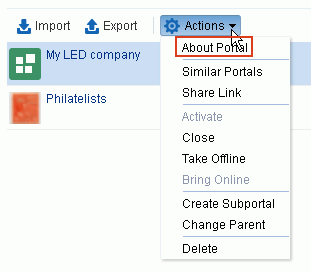
Description of ''Figure 46-6 Viewing Information About a Portal''
-
Explore the information in the About Portal dialog (Figure 46-7):
-
Name: Internal name of the portal displayed in the portal URL.
-
Display Name: Display name of the portal. This name displays at the top of the portal and other places where portals are available for selection, such as the Portals page.
-
Internal ID: ID of the portal, which other applications may use to reference this portal.
-
Description: A description of the portal, specified when creating the portal or in the portal administration settings.
-
Created By: User name of the portal creator.
-
Date Created: Date and time that the portal was created.
-
Direct URL: URL that provides direct access to the portal.
-
46.7 Viewing Similar Portals
A portal is considered similar to another portal if the same people perform similar actions in it, especially if they edit the content. Similar Portals is provided by the Activity Graph service. For more information, see the "Working with the Similar Portal Task Flow" section in Building Portals with Oracle WebCenter Portal.
To view a list of portals similar to the current portal:
-
On the Portals page in Portal Builder (see Section 46.2, "Accessing the Portals Page in Portal Builder"), select the required portal by highlighting the row in the table.
Press Ctrl+click to select more than one portal.
-
From the Actions menu, select Similar Portals (Figure 46-8).
-
In the Similar Portals dialog, select a portal to open, or click the Display Options (pencil) icon (Figure 46-9) to modify the criteria for similar portals.
Figure 46-9 Similar Portals Display Options Dialog

Description of ''Figure 46-9 Similar Portals Display Options Dialog''
-
In the Display Options dialog (Figure 46-9), enter the number of portals to display and the display criteria, then click OK.
46.8 Sharing the Link to a Portal
If you want to share a portal with others, you can publish a link to the portal that will appear in activity streams of other users. With appropriate permissions, users can directly access a portal by clicking the link that specifies the portal display name.
To publish the direct link to a portal:
-
On the Portals page in Portal Builder (see Section 46.2, "Accessing the Portals Page in Portal Builder"), select the required portal by highlighting the row in the table.
-
From the Actions menu, select Share Link (Figure 46-10).
-
In the Share dialog (Figure 46-11), optionally enter a comment to appear with the link.
-
In the Share with list, select who you want to share the link with:
-
Everyone to share the link with all members of the current portal in their activity streams. This is useful to notify members of updates to the portal.
-
Portals to open the Select a Portal dialog, where you can select a portal to share the link in the activity streams of all members of the selected portal. This is useful for sharing information with members of other portals who may be interested in your portal.
-
-
Click Publish.
46.9 Closing Any Portal
By default, a portal is active. You can close a portal that is no longer being actively used. Closing a portal archives its content. When you close a portal, it is removed from everyone's Portals menu and displays on the Portals page in the Home portal only when a user selects Closed from the Show list. The content of a closed portal remains accessible and searchable to those who still want to reference it and portal members can continue working in the portal either by displaying closed portals, or by pretty URL (http://host:port/webcenter/portal/portalName).
When a portal is closed, any activities performed in the portal are no longer reflected in the Activity Stream in the Home portal. Only the Home page of the closed portal shows activity in the portal.
If you want to close down a portal temporarily, take the portal offline instead. See Section 46.11, "Taking Any Portal Offline."
To close a portal:
-
On the Portals page in Portal Builder (see Section 46.2, "Accessing the Portals Page in Portal Builder"), select the required portal by highlighting the row in the table.
Press Ctrl+click to select more than one portal.
-
From the Actions menu, select Close (Figure 46-12).
-
Confirm the action by clicking OK.
Notice that the Active status changes to Closed (see Figure 46-13).
46.10 Reactivating Any Portal
You may close a portal if it is no longer being used (see Section 46.9, "Closing Any Portal"). If you want to reopen a portal, you can reactivate it.
To reactivate a portal:
-
On the Portals page in Portal Builder (see Section 46.2, "Accessing the Portals Page in Portal Builder"), select the required portal by highlighting the row in the table.
Press
Ctrl+clickto select more than one portal. -
From the Actions menu, select Activate (Figure 46-14).
-
Confirm the action by clicking OK.
Notice that the Closed status changes to Active.
46.11 Taking Any Portal Offline
By default, a portal is online. You can take a portal temporarily offline for maintenance. For example, if you notice inappropriate content, you can take a portal offline to modify its content, then bring it back online. Only the system administrator or portal members with Manage Configuration permission can access a portal that is offline, or bring it back online. Other members see the Portal Unavailable page (see Chapter 50, "Customizing System Pages").
To permanently close down a portal that is not being used any more, see Section 46.9, "Closing Any Portal".
To take a portal offline:
-
On the Portals page in Portal Builder (see Section 46.2, "Accessing the Portals Page in Portal Builder"), select the portal you require by highlighting the row in the table.
Press Ctrl+click to select more than one portal.
-
From the Actions menu, select Take Offline (Figure 46-15).
-
Confirm the action by clicking OK.
Notice that the Online status changes to Offline (see Figure 46-16).
46.12 Bringing Any Portal Back Online
To bring any portal back online:
-
On the Portals page in Portal Builder (see Section 46.2, "Accessing the Portals Page in Portal Builder"), select the required portal by highlighting the row in the table.
Press Ctrl+click to select more than one portal.
-
From the Actions menu, select Bring Online (Figure 46-17).
-
Confirm the action by clicking OK.
Notice that the Offline status changes back to Online.
46.13 Creating a Subportal
You can create one or more subportals in any portal. From a parent portal, you can navigate to its subportals (see Section 46.14, "Moving a Portal or Subportal (Changing the Parent)").
To create a subportal:
-
On the Portals page in Portal Builder (see Section 46.2, "Accessing the Portals Page in Portal Builder"), click in the row of the portal for which you want to create a subportal.
-
From the Actions menu, select Create Subportal (Figure 46-18).
The Select a Portal Template page appears.
For information about creating a subportal, see the "Creating a Subportal" section in Building Portals with Oracle WebCenter Portal.
46.14 Moving a Portal or Subportal (Changing the Parent)
WebCenter Portal system administrators with Portals-Manage Security and Configuration permission can move portals to become subportals or change parent for a subportal. All of the metadata (such as pages, navigation, security, and so on) and data is maintained when a subportal is moved.
To move one or more portals subportals from their current parent portal:
-
On the Portals page in Portal Builder (see Section 46.2, "Accessing the Portals Page in Portal Builder"), click in the row of the portal or subportal that you want to move.
To view the subportals for a portal, you can click the Subportal icon (Figure 46-19).
Press Ctrl+click to select more than one portal.
-
From the Actions menu, select Change Parent (Figure 46-20).
Figure 46-20 Moving a Portal to a Different Parent Portal
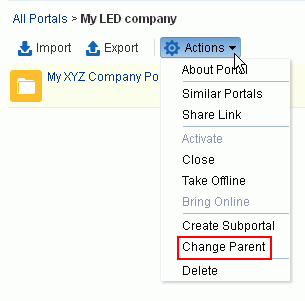
Description of ''Figure 46-20 Moving a Portal to a Different Parent Portal''
-
In the Select New Parent dialog (Figure 46-21), select the new parent portal, or select the No Parent Portal check box to move the selected portal(s) to the root portal of the portal hierarchy.
Note:
All portals and subportals in WebCenter Portal are listed, which means you can move a selected subportal lower in the portal hierarchy, under another subportal. -
Click OK.
46.15 Deleting a Portal
When a portal has been closed or inactive for some time, you may want to remove it permanently from WebCenter Portal. System administrators with the Portals-Manage Security and Configuration permission can delete any portal. Deleting a portal is permanent; it cannot be restored after it is deleted.
When you delete a portal:
-
All pages associated with the portal are deleted.
-
Links, lists, notes, tags, and events) associated with the portal are deleted.
-
Portal roles and membership details are deleted.
-
Content managed by discussions and announcements is deleted, when it is stored in the default forum or category created by the portal. Content managed by nondefault forums or categories is not deleted (for details, see the "Modifying Discussion Forum Settings for a Portal" section in Building Portals with Oracle WebCenter Portal).
-
The portal mail distribution list that is automatically created by the WebCenter Portal is deleted. However, distribution lists that are customized by the portal moderator are not deleted (for details, see the "Configuring the Mail Distribution List for a Portal" section in Building Portals with Oracle WebCenter Portal.
-
Content managed by external services, such as content repositories, mail, and so on, is removed.
-
If the portal is a parent in a portal hierarchy, child subportals are deleted too.
You cannot delete a portal while the moderator is editing portal settings, but there are no other restrictions.
To delete a portal:
-
On the Portals page in Portal Builder (see Section 46.2, "Accessing the Portals Page in Portal Builder"), select the portal to delete by highlighting the row in the table.
Press
Ctrl+clickto select more than one portal. -
From the Actions menu, select Delete (Figure 46-22).
-
Click Delete to confirm that you want to delete the portal(s).
If the delete process fails for any reason, the portal is not removed from your Portals tab; this sometimes happens when a back-end server cannot be contacted. If you click Delete again, the portal is removed.
